Garden Glimpses: Summer’s End
It’s been a hot, dry summer, and I’m not sorry to see it go. Total rainfall for July on the property was three quarters of an inch – yeah, you read that right! “Normal” (whatever that means anymore) is about five inches. August was little better, with just an inch and a third by late month. Temps were above average, too – Philadelphia experienced one of the hottest summers on record, with more than thirty days seeing highs of 90+, and the hottest average temperature ever for July and August.
In my constant battle with the elements, I lost more than a few rounds, and more than a few plants. Watering duties were far too extensive to continue by hand sprinklers, so it was time to drag out the 75’ hose and lug it back and forth across the landscape. I divided the garden into six zones, to ensure that I wouldn’t over-water and run the well dry again (though I did anyway on two occasions). All of eastern Pennsylvania and New Jersey are now officially in drought conditions, though water restrictions have not yet been applied locally.
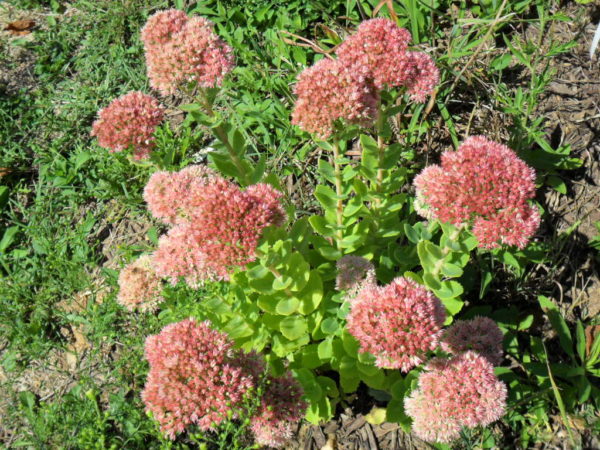
With climate change, there are no guarantees, but moving into autumn, temps should drop and precipitation increase. We’ve had a foretaste of this since September dawned, with almost two inches of much-needed rain on the 5th, and another round occurring as I write. I haven’t had to water in a week, and with what we get today, I might be able to push that to two weeks. This is living!
My losses haven’t been too heavy, but with my local perennial farm owners retiring this year, some of the plants are irreplaceable. I’m talking about you, Toad Lily, my beautiful, late-flowering shade-lover, with the stunning orchid-like purple blossoms. After thriving for three seasons, it’s a goner. I’ve lost more ferns than you can shake a frond at – goodbye, Bracken fern, sayonara Japanese painted fern, adios Lady fern! On the plus side, I’ve found one that actually works in these conditions – Autumn fern. And I still have a local source for that – more, please. Christmas fern is a newcomer this year, and is also holding its own, while Sensitive fern, which spread hugely this spring, is looking very battered indeed, but hasn’t quite given up the ghost; we’ll see what it looks like after a long winter’s nap. The meager advantage to this loss is that I now have half a dozen or more holes ready-made to receive their replacements, without the effort of digging into the rooty soil under the birch.
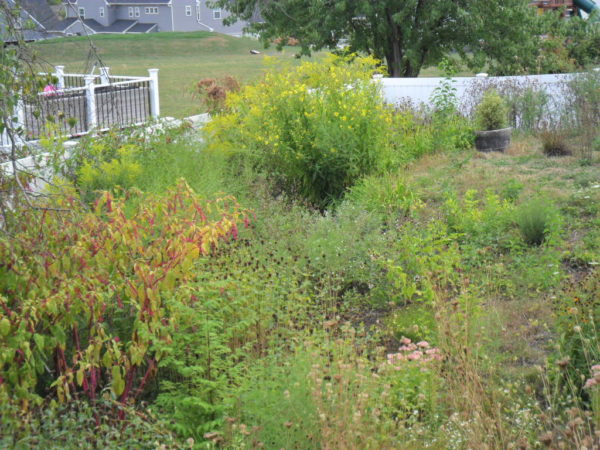
Every day I bless my natives. I originally planned to devote about a third of the yard to whatever wanted to be there, but that percentage grew as the vast scope of my garden rehab project began to register, along with my inability to provide the energy needed to accomplish and sustain it. I estimate that between half and two-thirds of the garden is dominated by native self-sown plants now, and after a summer like this, I wouldn’t have it any other way!
I gave no hydration support whatsoever to the natives, and though they flagged and looked like hell for much of the driest periods, I didn’t actually lose a single one. As soon as the rain fell, they bounced right back. Even a passing shower dumping a quarter inch was enough to revive them temporarily. And the drought also slowed the spread of weeds (which would be natives that I don’t want in my garden!), so that was a plus.
Now, as summer wanes, there’s a lot more brown out there than I’m used to at this time of year, but there are lovely highlights as well.
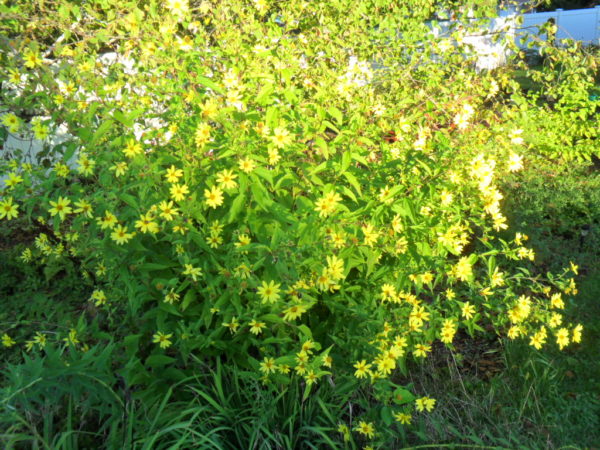
I’m still settling into the rhythm of my wonderful Lemon Queen perennial sunflowers. In their first year, they held off bloom until September, as they were billed to do, but last year they began to open in early August. This year was a mix, with some few blossoms open by Lammas, but then a sort of stasis ensued, perhaps drought-driven, and they are just now coming into full flower. They have become massive behemoths, straddling the eastern and western sides of the top of the sandmound, beacons of color and always buzzing (literally) with pollinator activity.
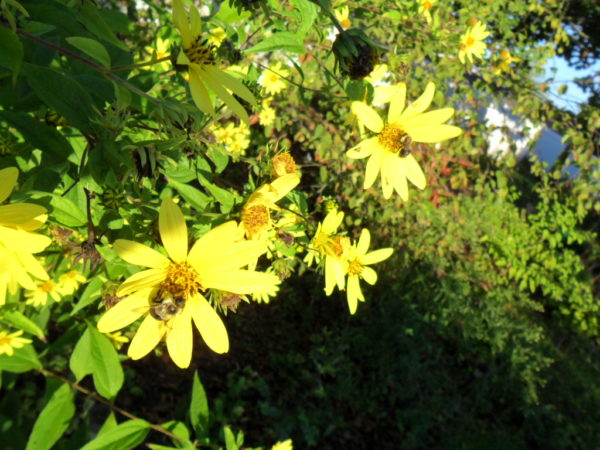
I’m also enjoying my wide array of sedums, tailor made for these drier conditions. Some of the lower, groundcover varieties bloomed in late spring or early summer, but the taller ones are just at peak now. Autumn Joy is a popular planting, and justly so – up to two feet tall with masses of deep pink buds opening to dusty rose, it’s a great foundational sedum. I planted just two of these in my first year here, which have thrived, but I acquired five more last fall, when a neighbor was downsizing her garden and had small pots of them by the roadside, for whoever wanted one. I ringed these around the seating area on top of the sandmound to ensure some fall color there, and they are doing very well in their first season of bloom here.
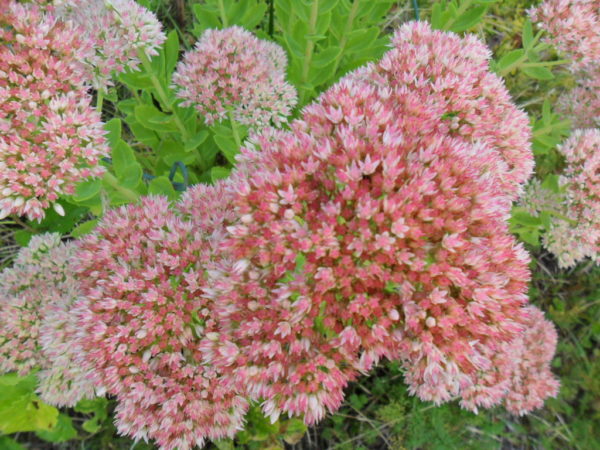
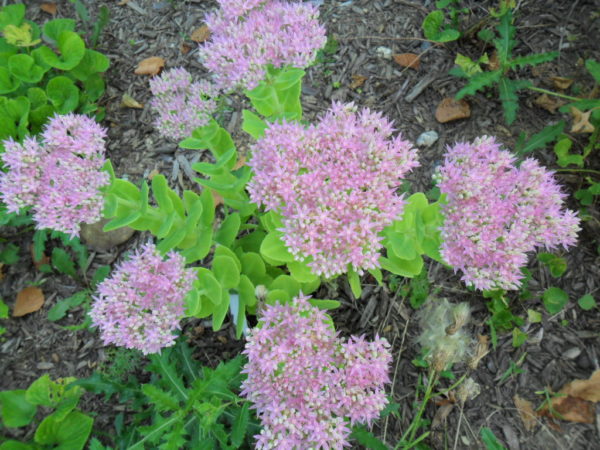
Touchdown Teak has purplish foliage and intense purple-red blossoms, a truly stunning sedum if ever I saw one. It hasn’t expanded as much over last year’s growth as I would have expected, but that, too, may be drought-related. Sedums are types of succulents, and require little water, but they do need some, and my newest arrivals are very exposed to blistering sun on the sandmound, which due to its elevation is among the driest spots in the garden. This spring I ringed the front edge of that bed with delosperma ice plants and groundcover sedums, all of which have bloomed out by now, but they seem to be doing well, expanding rapidly beyond their original size.

Another late summer, earl fall bloomer is Ironweed, with long 2-3-foot stems covered with almost ferny foliage, and topped with fuzzy masses of deep purple blossoms. With the sedums, it creates a pop of color in the pink/purple spectrum, which is rare in late summer, until autumn asters and chrysanthemums kick in.

Helenium is a great addition to the late summer garden. There are many varieties of these brown-button-centered, daisy-like flowers, in the fire tone range from yellows through oranges, reds and maroons. They are fairly drought tolerant, though they tend to die back leaves along the lower sections of their stems when it’s very dry, which is not attractive. The flower clusters, however, remain lovely and add good color to a landscape which is becoming increasingly drab. After peak flowering, the blossoms turn a dun or sepia tone, but retain their shape; I haven’t tried drying these yet, but it’s on my list!

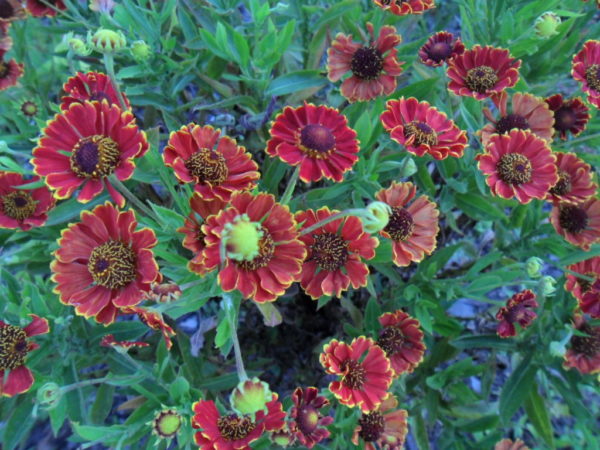
Calamint is also a late-starter, but once it kicks off in late July, the bloom just keeps coming and coming, all the way to frost! A mint relative, calamint’s full clumps of delicate elongated stems are covered in miniscule white blossoms, bottom to top, and positively glow at sunset.

A new addition for me is Chelone, AKA Turtlehead. Tall spires up to four feet are spiked with rows of bright, medium pink blossoms that encircle the stem along the top third. These are somewhat odd, in that they resemble snapdragon blossoms that are just about to break, but they never actually open, remaining puffed, almost like a Lady Slipper. They really do resemble the head of a turtle, just emerging from its shell, albeit one pretty in pink.
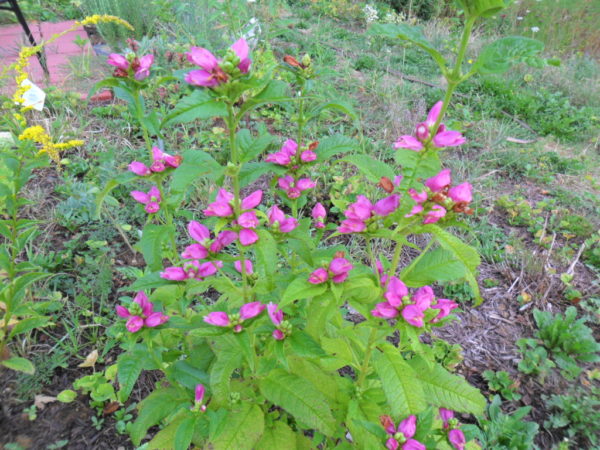
But Solidago – goldenrod – is the queen of the late summer/early fall garden. I have at least five different varieties on the property, three natives and two imports (which are also native to the Northeast, just not my garden). With sturdy stems up to six feet high, some sport fluffy, relatively small masses of rich golden fuzz, bunched together like a feather duster; others have large, branching tops, more than a foot long, each with smaller fuzzy ends that together form one mass of bloom. One, an import called “Fireworks”, blooms all along its willowy side shoots that emanate from the robust stems starting about two feet off the ground, each covered in bright yellow blossoms that cling tightly to the stems, but bloom from base to tip, rather than a clustered mass at the top.
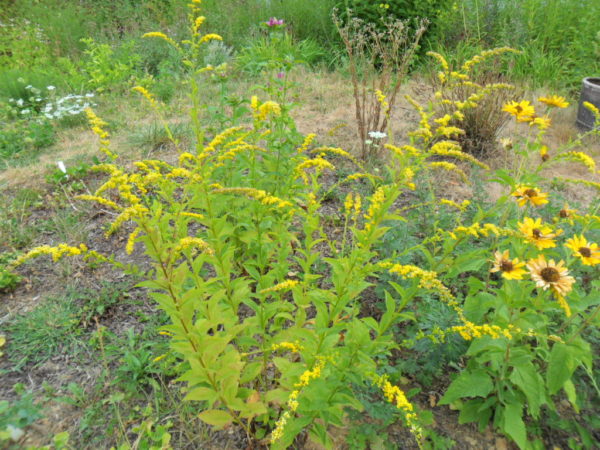
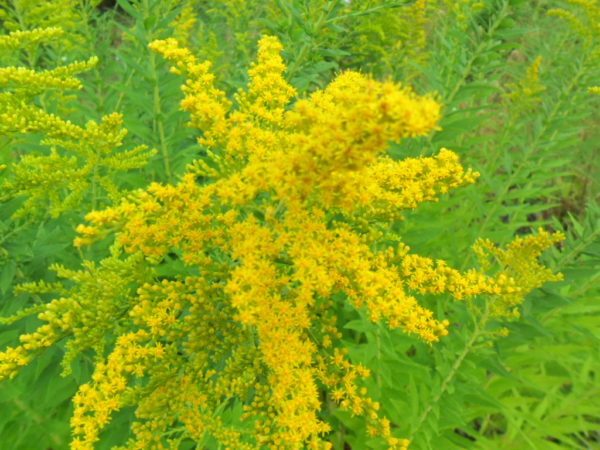
The oakleaf hydrangeas are long since bloomed out, but still lend interest with their dried blossoms, now sepia-toned or browned. Queen of Hearts, so dazzlingly white when it first bloomed, never did mature into the rosy pink that gives it its name, but I’m inclined to give it a pass in this, its first year here. Perhaps over time it will perform better; it’s now a very dark brown, not unattractive, but a far cry from pink.
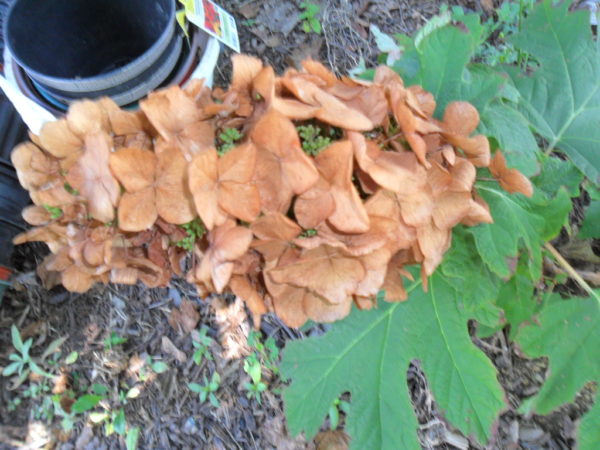
But the arborescens hydrangea, Annabelle, has exceeded expectations. Much more prolific than its larger-leafed cousins, those pristine rounds of white have matured into a very pale minty green, quite lovely, and still looking fresh into September. A few weeks ago, I cut samples of several varieties to dry for arrangements, and I’m quite pleased with the results. As these plants mature in size, that will become a staple of my late season harvesting.
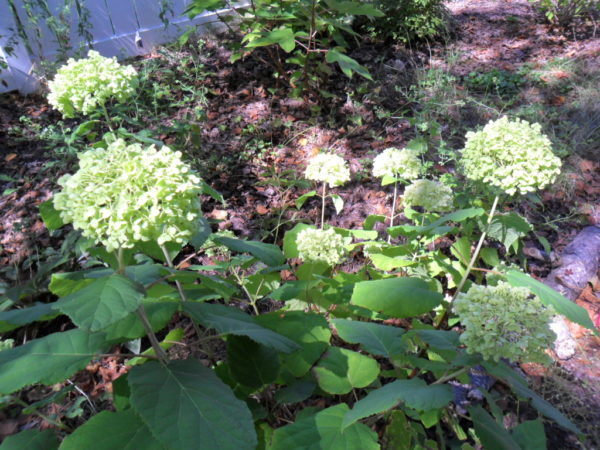
I don’t have many hardy mums, but the few which returned are loaded with buds, just beginning to swell as we move into mid-September. I’ll be buying more in pots to supplement them shortly.
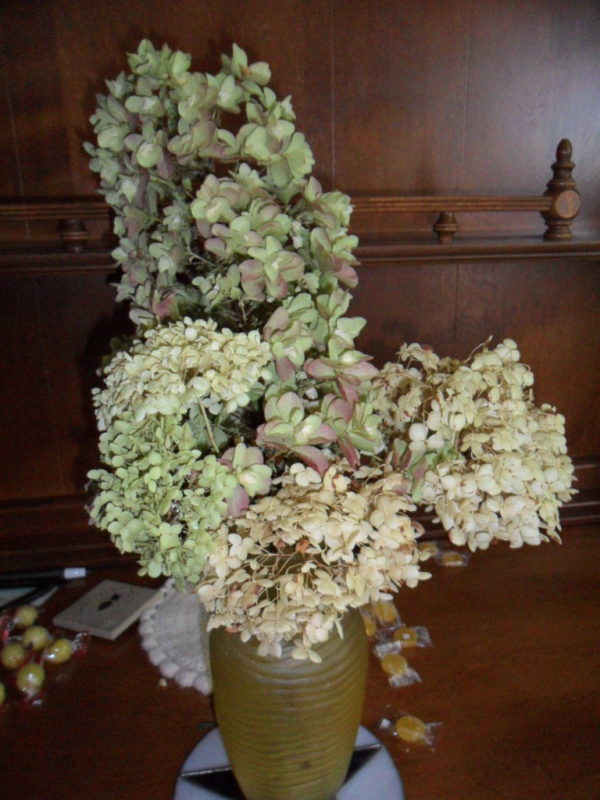
The wild white asters are just starting to open, and are so massive, it will be weeks before they’re at peak. I’ve allowed more small stands of these to thrive this year, as I devote more and more space to natives; within another season or two they’ll be as massive as the ones that originally sowed themselves here, three years ago. I also have pale lavender varieties and my lovely medium-purple Michaelmas daisy outside the garden gate. This should have been divided last spring, it’s getting too large and will overwhelm my autumn pumpkin, straw bale, and gourd display, but it’s far too late to do anything about it now, so I will likely just cut more from that for indoor bouquets than I normally would, and hope I’ll be more responsible in dividing it next spring.

Pokeberry stems are vivid magenta, and stand out very starkly after so many leaves were lost to the drought; those that remain are yellowing, and provide a lovely contrast to the purplish stems. The purple-black fruits are fully ripe now, and most dangling clusters have already been robbed of their plumpest members by the birds, who will then crap out their seeds and give me yet more pokeberries next year!
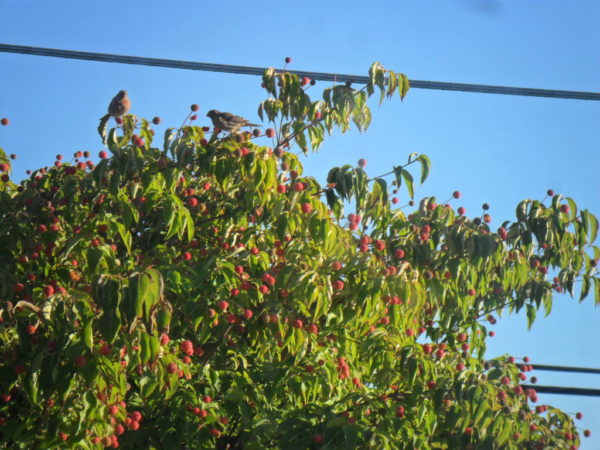
The dimpled pinkish-red fruits of the Chinese dogwood, looking like so many medieval maces, are ripening and attracting pairs of catbirds and finches for lunch. I can see their antics just outside my office window, but it will be well over a month before the foliage turns its gorgeous hues of yellow, orange and red. Eat up, guys! Every fruit you take is one less to fall onto my walkway and be ground under heel!
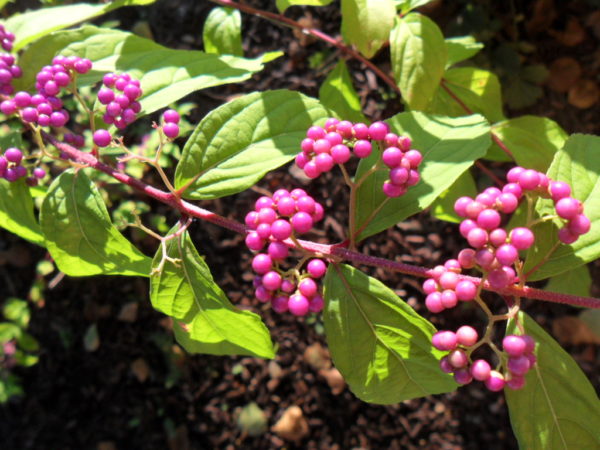
Beauty Berry is also ripening, with clusters of tiny electric purple fruits at regular intervals along its long, willowy stems. The color of its berries seems impossibly fake, and has few matches in nature, but feels somehow appropriate to the season, like miniscule grapes (though you never saw a grape so flamboyant!). I had quite a bit of dieback on this plant over the winter, but it rebounded nicely, looks very lush and full, though it did require a lot of water support this summer, and flagged in the heat and drought. I’m sure I’d have lost it without frequent dousings. Supposedly birds love the fruits, but their depredation was minimal last fall, we’ll see if they’ve found it this year. Unfortunately the color doesn’t last, and by year’s end the berries will be straw-hued and lifeless, making them useless as yuletide decoration.
I saw something recently I’ve never seen before, and which really perplexed me. It was a hummingbird, assiduously probing a dried branch of wild mint, with only spent white-tan miniscule blossoms adhering. The local hummingbird population has temporarily swelled as their migration begins, but normally they are attracted to bright colors and tubular or deep-throated flowers. I have no idea what this fellow wanted with a dead mint flower, but I hope he got what he was after.
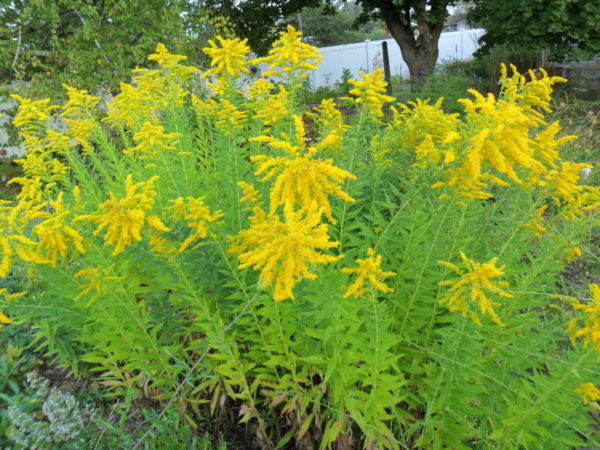
White snakeroot is another native starting to set buds. Its clusters of fuzzy small blossoms stand out in the shade garden, bright white focal points lighting up the fading greenery. These natives are among the last to bloom, but we still haven’t heard from the helianthus “Autumn Gold” or the Montauk Daisy.
As the botanical name implies, “Autumn Gold” is yet another type of perennial sunflower, but not nearly so massive as Lemon Queen. And it blooms much later – it hasn’t even set buds yet, and probably won’t bloom until nearly Halloween, when it will bring a very welcome pop of sunny yellow to the garden.

Close beside it is Montauk Daisy, a wonderful, sturdy perennial that is more shrublike, in that it doesn’t die back to the soil in winter. This allows it to put on considerable heft over the years – the friend who gifted me with a seedling of this has a mama plant that is almost as tall as me, and a good six or seven feet in girth. The bright white petals are centered with dots of brilliant yellow, and Montauk is the last to bloom, often not coming into peak until well after Halloween. Mine took a real pounding from the drought this year, despite regular watering, with dieback clear up to the tips of its branches, which now resemble the pompon on a shaved poodle’s tail. No buds there yet, either, and the drought might have squelched that, too.
We’re getting some cooler nights as September commences, into the low 50s, even upper 40s, such a refreshing break from August’s swelter. Soon it will be spooky season again, and then all this drought-induced dead vegetation will be atmospheric and creepily apropos.
On to autumn!
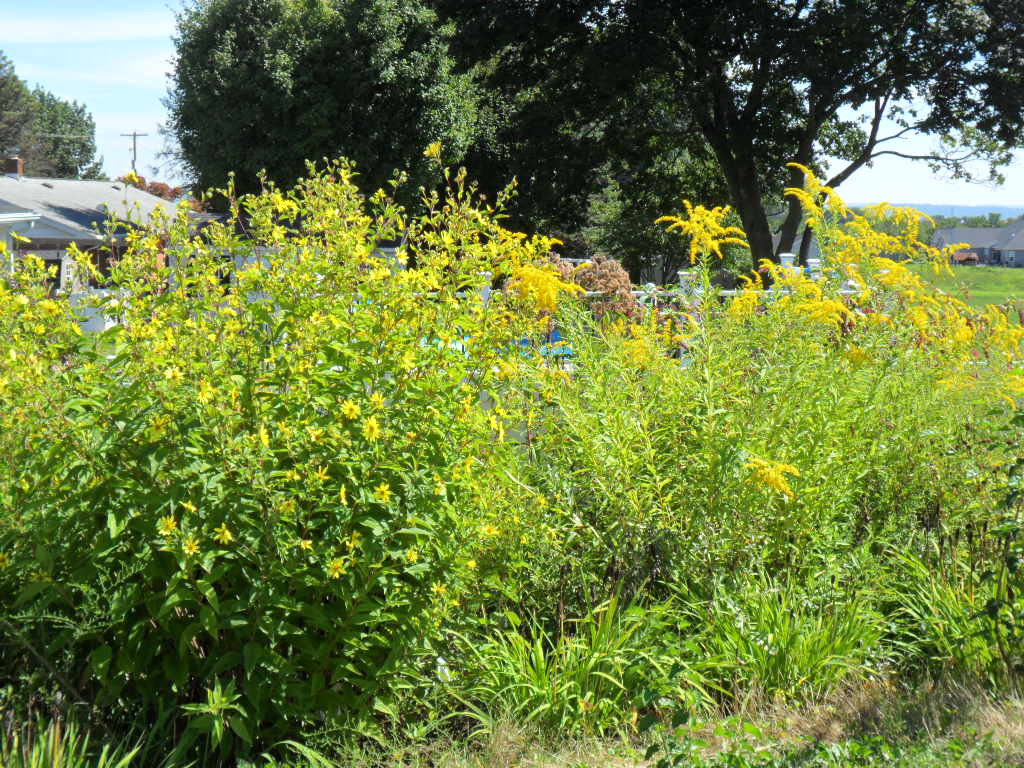

One comment, add yours.
Laurien
Despite suffering a drought I think your garden has fared incredibly well, thanks to all your hard work. It’s a wonder you find time to write about astrology! I think a lot of people will be turning to native plants because of climate change so you are ahead of the crowd. I really enjoyed all your photos and your dried hydrangea flowers may inspire me to cut some from my Annabelle hydrangea to dry out. It’s always a nice break from depressing news to read your garden articles, Alex. Thank you!